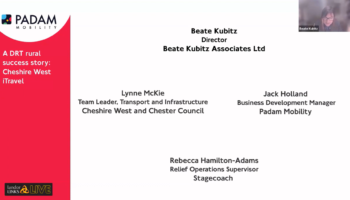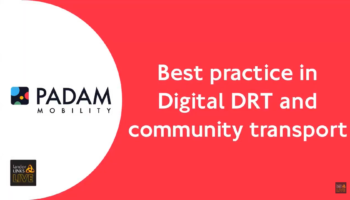There is no better than our trusted sister company, Hacon, to talk about the topic of Mobility-as-a-Service. The company specialises in developing software solutions that connect different modes of transport into an intermodal travel chain. We interviewed Svenja Katharina Weiß, Marketing Manager and Thomas Wolf, COO of Hacon on their experiences and future visions of MaaS.
As a leading provider of mobility apps, what experiences have you gained with Hacon so far in the development and implementation of MaaS apps?
Thomas Wolf (TW) : We have noticed that the app is the part of the solution that everyone sees and gets in touch with so it’s of course an important aspect of the overall solution. But actually, we talk a lot more about MaaS platforms than MaaS apps. Why? The app is of course the customer-facing part, and again it’s very important to make sure that there’s great usability, but the intelligence is more in the back office. Implementing a mass project is all about the back office: it’s about gathering the right data connecting with a huge number of mobility service providers and of course to have a back-office system that helps people to make smart decisions. I would also emphasise that the key aspect of Mobility-as-a-Service is using the system to get access to smarter and faster options. A trip not found will not be booked: MaaS offers a whole new range of opportunities for the passengers and makes people explore their options quicker.
Svenja Katharina Weiß (SKW) : I’d like to add that not only different modes [of transport] but also different actions or processes have to be integrated. We like to call it “Plan, book, pay and travel with one app and one account”. MaaS has to accompany the user through the whole trip and everything that is associated with it. I believe that is the great potential of MaaS regarding intermodal travel that it fits the individual demands even better than single modes of transportation.
What is your motivation to advocate for a stronger MaaS approach and to further develop shared intermodal mobility?
TW: MaaS has become more popular over the past years. One reason for this is that the public and politicians aim to reduce carbon footprint. If you want to achieve this goal, there are all kinds of things you can do and need to do, but one thing people want you to do is to eventually abandon your own car. On the other hand, if you want to abandon your car, then the problem is you need mobility services for every aspect of your life. In that perspective, a car is quite hard to beat because it has been developed to fulfil all these different needs or pretty much all of them.
This is where MaaS comes in because instead of just either riding the train or the bus or bike or renting a car it should give you access to all of these mobility modes. For example, if you would need a car because you want to pick up building material which is going to be difficult by using a bus then you’re just going to use a car for this particular trip thanks to MaaS recommendations. In a nutshell, MaaS must give people a true alternative to car ownership and that’s why I think it is an important topic these days.
It sounds like MaaS is also about creating a highly individualised travel experience. Is it already possible, for example when creating a user account, to set specific preferences on how somebody would like to travel?
TW: Yes, we do offer personalisation. There exists already a variety of options a user can choose from, of course, they can also choose if they do or do not want to use bikes depending on their personal situation. But I think when we talk about preferences in MaaS, an important aspect is people with reduced mobility. In this specific regard, we have lots of options we can offer as well as tools to manage the data. For example, when a wheelchair user arrives on a platform and wants to continue the trip, he or she needs to know if there is a functioning elevator and of course what to do if not. So we can actually route people around a problem. And even though that sounds like we are now talking about the details but in reality, if you are depending on a wheelchair – or have any other kind of disability – then you need to rely on the system, that is something that goes beyond a fancy app and nice-looking interfaces. We need to be able to provide a professional system that takes care of all those details. Especially when it comes to public transport, we have a high responsibility towards disabled people. And that is why I am bringing up that specific example because it goes above and beyond the luxury of preferences.
SKW: I would like to emphasise the importance of data in order to enhance the overall MaaS experience. On the one hand, MaaS platforms are heavily dependent on high-quality data. This applies, for example, to timetable information or real-time data on the location of vehicles and their availability. This data must be reliable and managed efficiently and securely between the stakeholders. The same applies to the handling of account and payment data e. g. On the other hand, MaaS platforms are generating data and offer great potential for using mobility data analytics to create ever better, tailored mobility offers and to enhance service strategies.
What happens to the data that the MaaS platform collects? Among the great diversity of MaaS stakeholders, who should “own” this data? Who can in theory use it for data analysis purposes? And how do you or other hosts of MaaS platforms make sure that the data stored is compliant with the EU data protection regulation (GDPR)?
TW: We firmly believe that the data which is generated by such a system belongs into the hands of our customers. Meaning in most cases public transit agencies, public transit operators or in short the public. Because we pay taxes so that there’s public infrastructure, we build public infrastructure and we provide public infrastructure, this is why we believe that the data being generated from such a system belongs to the public – it’s that simple!
Our key philosophy is we provide technology and our clients own the data. They need to be in touch with their users to know if they are happy with the service and to be able to reach out to them in case of an issue. If you don’t own the data you’re not in touch with your users anymore. And we believe that it is mind-blowing if you depend on a third-party provider to learn about what is going on in your own infrastructure.
And to the aspect of storing data in a GDPR-compliant way, this is not only a crucial aspect for our customers but also for the end-users, the passengers. Of course, we are making sure that this data is handled appropriately, we will make sure that nothing wrong happens with this data and that users won’t, all of a sudden, just because they used a MaaS-System or rode a bus, receive advertisements that they never wanted. This is not going to happen with our systems. We believe it is absolutely fundamental that the data stays with our clients and that we store and handle this data safely.
MaaS can have the power to bring together and connect different territories, including the most fragile. To do this, we need to develop digital services that provide quality intermodal information. But what are the other major challenges facing MaaS in low-density, rural areas?
TW: First and foremost, mobility in rural areas is a much bigger challenge than it is in Metropolitan areas. Ironically, even though there are traffic jams in the Metropolitan areas, there are also the most travel options, especially for sustainable travel. It seems absurd but the new modes of transportation show up in areas where you don’t desperately need them because in most cities the public transportation is very good. In contrast, rural areas are clearly not as attractive for anybody who offers mobility services, so I think it takes extra effort to have attractive transportation in rural areas. In my opinion in less densely populated areas, we just have to use resources in a smarter way: for example, integrate the taxi services that are available already and make them more accessible.
What could be the role of DRT-Services in a MaaS-System, less densely populated areas?
TW: We have noticed that cities or public transit agencies when they think of Mobility-as-a-Service want to offer mobility alternatives to car ownership for a certain region. That means they want to offer a mobility solution for every aspect of people’s life. But if they look at their current infrastructures they eventually find certain gaps and issues – for example at night times or in rural areas.
This is where DRT comes in, it helps to fill those network holes. Whether network holes in a geographical meaning where there is only a poor existing transit service or network holes in a temporal meaning, for example, during night hours, where it simply does not pay off to have a fixed bus line service.
I think that’s the exciting part, MaaS can help to orchestrate this very well and make sure that we deploy DRT exactly where it complements existing infrastructure and public transportation.
As of today, there are not a lot of DRT services that are integrated into MaaS systems. How do you explain that? Is it because DRT is a rather young technology?
TW : Yes, I think that is simply because the technology is still emerging, it’s still an area that hasn’t been around for too long, and also, I believe people sometimes make the mistake to think that if you set up a DRT system you need to set up additional vehicles and drivers, which of course you could, but again I need to emphasise that in many cases drivers are already around. Often there are already existing operators, for example, taxi organisations, that have existing vehicles and drivers. So, I think if cities or public transit agencies realise that they can tap into this potential by just linking it smarter with a DRT-software, like Padam Mobility’s system. I think we need to educate them better and show them that they don’t always need a complete fleet and drivers but in most cases just the software.
SKW: I think it’s important to acknowledge that DRT should complement the existing public transport services and that there doesn’t need to be the fear that it will cannibalise the existing services. It’s an addition, it’s a very smart complement. Of course, it has to be orchestrated but I think there can be a synergetic relationship between public transport and DRT. But yes, there still is a need for education.
This article might interest you: Crossed views on MaaS with Kisio Digital





